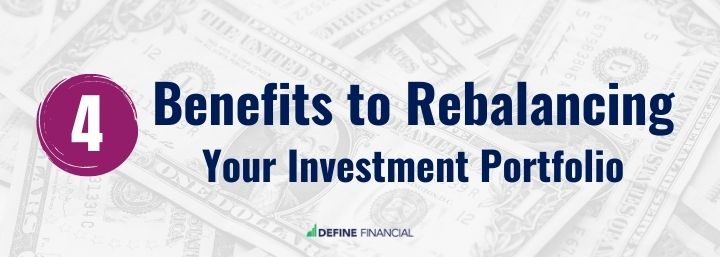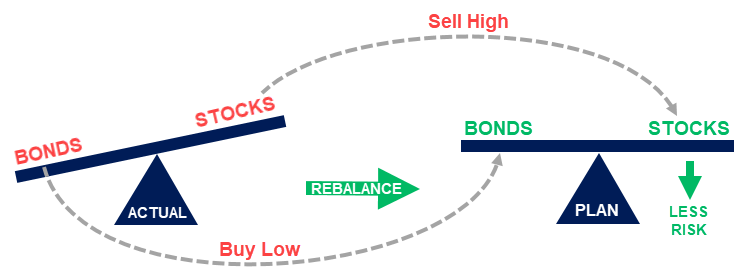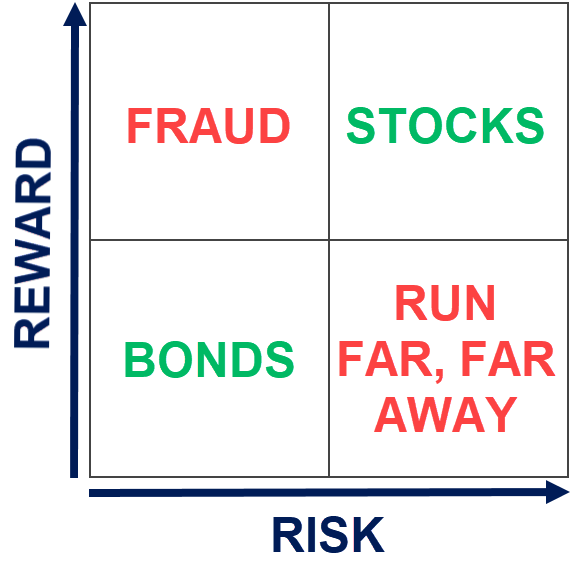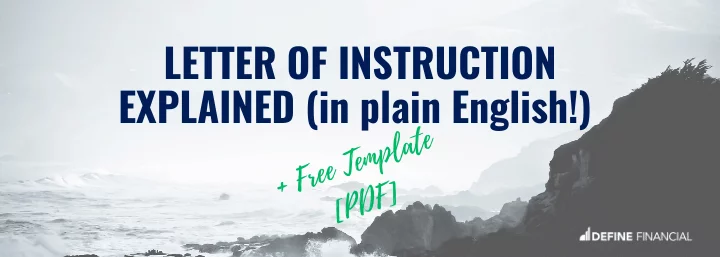
Today I’m sharing what portfolio rebalancing is, when to implement it, and why it’s so beneficial.
Market ups and downs make it difficult to know when to make adjustments…and when to leave everything alone.
But creating a systematic rebalancing plan can help.
So if you want to learn how to invest smarter without working harder, you’re going to enjoy today’s post.
What is Rebalancing Portfolio?
Knowing which stocks buy and sell is difficult, even for the most experienced investors.
Asset allocation is one solution that helps make the process easier and is the preferred approach for most long-term investors.
The right asset allocation will vary according to each investor’s unique situation and needs based on their risk tolerance and investing time horizon. Their portfolio allocation will generally be some combination of stocks, bonds, and cash.
Ideally, an investor will have a target asset allocation that aligns with their needs and goals as defined in their Investment Policy Statement (IPS). A proper IPS will also outline the parameters under which the portfolio will be rebalanced.
For example, the allocation of one or more of the asset classes within the portfolio varies +/- 5% from its target allocation.
Over time, the relative values of your individual investments will fluctuate. Rebalancing your portfolio is the process of bringing its asset allocation back to the target percentages you’ve established.
The need to rebalance arises from the often-uneven performance of different types of investments under various market and economic conditions.
Rebalancing Your Portfolio: An Example
Let’s say an investor has a simple portfolio with a target asset allocation of:
- Stock ETF allocation: 60%
- Bond ETF allocation: 40%
Over time, the allocation will fluctate based on market and economic factors.
For example, if the stock market skyrockets and you don’t make any portfolio changes, your allocation might end up looking like this:
- Stock ETF allocation: 80%
- Bond ETF allocation: 20%
At this point, the over-allocation to stocks is causing your portfolio to take on more risk that you might be comfortable with. Should stocks head down, your portfolio is more susceptible to risk than outlined in your IPS.
To counteract this, you will want to reduce your exposure to the stock ETF to bring it back down to its target of 60%. This will increase your exposure to the bond ETF and bring its allocation back to its target of 40% of the portfolio.
Think of it like a puzzle. As the value of each asset class moves in different directions, you may need to periodically put the puzzle pieces back together to keep the portfolio aligned with your IPS.
When to Rebalance Your Portfolio
A key point that we want to emphasize is that rebalancing should be considered at reasonable intervals. Typically, this is done quarterly. For many investors, it might be semi-annually or even annually.
Exceptions to this would be after a major market move up or down. Another exception would be having a significant amount to invest in a lump-sum. In this case, it makes sense to direct that money towards underweighted holdings to rebalance as needed.
Portfolio rebalancing is often accomplished by selling holdings in asset classes where the portfolio is overallocated. Then you redirect those funds to positions in underweighted asset classes. In doing this, it’s important to take a total portfolio view. You’ll want to look at taxable accounts as well as retirement accounts like an IRA or your 401(k).
Another way you can accomplish rebalancing, all or in part, is with new money added to your portfolio. These new funds should be directed towards positions in underweighted asset classes first. New money might include contributions to an IRA, 401(k), or a self-employed retirement account.
The Top 4 Benefits of Portfolio Rebalancing
We are strong believers in rebalancing for these reasons.
1) Maintaining your intended asset allocation and risk exposure
The purpose of rebalancing isn’t to beat the market, it is to manage risk. While studies have shown that your portfolio’s asset allocation is the most important component of your investment return, it is also the key factor in determining the level of risk that you take on as an investor.
While it may be tempting to “let your winners ride” when the market has experienced a period of solid gains, a continued overallocation to stocks can result in outsized losses when the market invariably heads down during the next correction.
2) Buying low and selling high
This is the dream scenario for all investors. It sounds easy but timing the market is a losing game in the long run. Rebalancing inherently directs investors to sell assets that have experienced higher returns and buy more of the assets that have experienced lower returns.
This may sound counterintuitive, but rebalancing is effective in helping you manage market risks over the long run.
3) Sticking to a rules-based approach
Money is an inherently emotional topic. These emotions can be further exacerbated by the fact it is impossible to consistently time the market.
This can fuel regret at missing that hot stock or new opportunity and might cause you to jump in after a security has experienced a sizable gain. Fear of missing out (a.k.a FOMO) can be a powerful and potentially damaging emotional response.
It’s important to keep your focus on track with your long-term investment plan, and away from the latest headlines. It is best practice to rebalance your portfolio based on predetermined rules. This might be very six months, annually, or when your stock/bond allocation falls x% outside of your IPS targets due to a significant market event.
In the end, a rules-based approach takes the emotion out of managing your investments.
4) Hold your financial advisor accountable
Investors place a lot of trust in their financial advisors. Having an IPS in place ensures your advisor keeps your portfolio in alignment with the plan you’ve agreed to.
Reviewing your portfolio for potential rebalancing at regular intervals and after significant market moves is one way to be sure that your advisor is helping you stick to the plan.
What are the Potential Drawbacks of Rebalancing?
Selling High and Buying Low
Selling the best performing asset classes in favor of the lower performers seems counterintuitive. By doing so, you may be sacrificing potential long term returns. This should come as no surprise because stocks have historically produced higher returns than bonds over long periods.
The key here is that as your expected rate of return increases over time, so does your portfolio’s risk. If your allocation no longer aligns with your risk tolerance, you could be in for a rude awakening when (not if) the market experiences its next rough patch.
Corrections are an inevitable part of being a long-term investor. Thinking that this time is different always ends badly.
Transaction Fees
As trades are entered to rebalance your portfolio, there may be transaction fees and/or commissions involved. Some of these might be a function of normal trading costs for ETFs, stocks, or some mutual funds depending upon your custodian’s platform.
If you work with an advisor whose compensation is derived all or in part from the commission paid to them, this type of situation should raise some questions in your mind.
While sometimes it is impossible to avoid transaction fees, there are many cases where these costs can be avoided altogether. This is why it is critical to work with a fee-only CERTIFIED FINANCIAL PLANNERTM whose fiduciary duty requires them to avoid unnecessary fees.
Taxes
Rebalancing can trigger capital gains, which are taxable if they occur in a taxable investment account. Your advisor should be conscious of your tax situation, but sometimes this is unavoidable in the course of rebalancing.
While nobody likes to pay more taxes than needed, it is usually better to pay some extra taxes on investment gains than to experience significant losses during the next market correction.
Final Thoughts: Rebalancing Your Investment Portfolio
Successful investment management starts with having a strategy that is based on a solid plan. Think of the IPS as a business plan for your portfolio.
Periodic rebalancing ensures your investments do not stray too far from your investment plan as detailed in the IPS.
If you’ve hired a fee-only CERTIFIED FINANCIAL PLANNERTM who acts in a fiduciary role in serving their clients to help create your financial plan, it is their job to do everything they can to help ensure your financial success.
A well-crafted plan, including an IPS for your portfolio, is a key part of this process.






